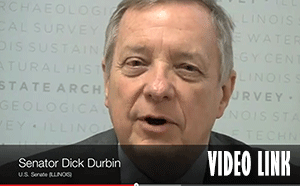Senator Richard Durbin (D-Ill.) toured the Abbott Power Plant at the University of Illinois on Jan. 15 for a briefing on Prairie Research Institute (PRI) research to develop next-generation carbon capture technology.
PRI has just released an informative video introduction to the work underway at the Abbott Power Plant.

The first-hand look at the project was an “eye opener,” Durbin said. If selected for the federally funded project, the technology would economically extract at least 90 percent of the carbon dioxide following an Abbott Power Plant retrofit. The ramifications for coal-rich Illinois – for jobs, the economy, and keeping utility rates low – could be profound.
“What’s going on here at the Abbott Power Plant is an effort to show that there is an environmentally responsible way to deal with the sources of energy whether they’re coal, natural gas, or oil,” Durbin said after the tour. “We’re working with the university, and the power plant, on an application for a Department of Energy research effort; and their goal, of course, is to take even more of the emissions and turn the pollution into profits and make certain that it doesn’t at least harm the environment in serious ways.”
For many nations around the world where coal is likely to remain the fuel of choice well into this century, the new technology could be a game changer in the challenge to limit global warming. The project includes expert advisory panel representing some of the largest power producers around the world, including China, India, and Brazil, said Kevin O’Brien, director of the Illinois Sustainable Technology Center and primary investigator for the project.
“We’re living in an era of dramatic change,” Durbin said. “Ten years ago we depended on OPEC oil. Now we’re talking very seriously about climate change and the need to reduce emissions.”
 He praised the efforts at the University for keeping the more than 70-year-old plant at the forefront of efficient and effective technologies to deliver both steam and electric power to students and staff. “It still serves the campus today,” Durbin remarked. “The good news is that over the years there have been some dramatic efforts to modernize this plant and to make sure that it not only meets the standards but goes beyond, and sets the standard for new technology and new energy development.”
He praised the efforts at the University for keeping the more than 70-year-old plant at the forefront of efficient and effective technologies to deliver both steam and electric power to students and staff. “It still serves the campus today,” Durbin remarked. “The good news is that over the years there have been some dramatic efforts to modernize this plant and to make sure that it not only meets the standards but goes beyond, and sets the standard for new technology and new energy development.”
“So it was good to see this first hand today — to be educated. I will tell you that it came as an eye opener to me. The steam generation and how important it is to the University of Illinois and also very important to generate the kind of electricity that sustains a modern campus in the 21st century.”
The project would put Abbott well beyond existing standards for emissions control. Abbott’s current pollution control technology, consisting of a combination of electrostatic precipitators and a flue gas desulfurization unit (scrubber), remains the “best available control technology” for removing pollutants from the byproducts of coal combustion.
The carbon capture research project also will look ahead to developing new uses for waste carbon dioxide. The project seeks partners interested in forming and building the overall “value chain” for captured CO2 – including members/ suppliers to the coal and power industry, and current and potential end-users of CO2. To learn more about the opportunity, call +1 (630) 472-5016.










